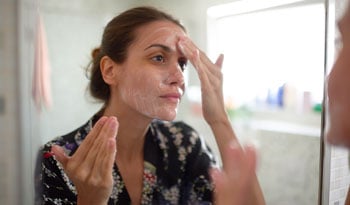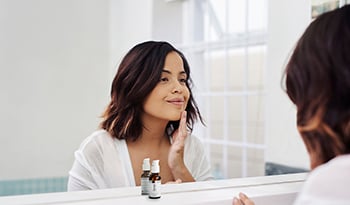How to Treat Perioral Dermatitis Naturally
DISCLAIMER:This blog does not intend to provide diagnosis...
- In this article:
- What Is Perioral Dermatitis?
- What Causes Perioral Dermatitis?
- Are You Using Steroids?
- Does Your Toothpaste Have Fluoride?
- What Kind Of Mask Are You Using?
- Are There Harsh Ingredients In Your Skincare?
- Are You Deficient In Zinc?
- Have You Tried Sulfur?
- Have You Seen A Professional?

Perioral dermatitis can be a challenging condition to treat, and is often quite frustrating for patients. Let’s dive into why.
What Is Perioral Dermatitis?
Perioral dermatitis is a rash that presents with redness, irritation, and pimples in the region around the mouth and creases of the cheeks. The area immediately around the lips is usually spared.
Sometimes the rash is itchy, and sometimes it can burn. Dermatologists call this condition “periorificial” dermatitis when it presents around other “orifices,” such as around the eyes. I see it almost exclusively occurring in women, but lately there has been an explosion of cases due to all the mask-wearing we’ve been doing.
What Causes Perioral Dermatitis?
The exact cause of the rash is unknown, but it is similar to rosacea and is likely caused by a number of different factors. Perioral dermatitis can be caused by topical or inhaled steroids (like hydrocortisone cream or steroid inhalers) on facial skin, fluoride-containing toothpaste, excessive warmth and moisture (as with masks), irritation from using too harsh or too many skincare products, or because of occlusive skincare products.
If you’re trying to treat perioral dermatitis naturally, here are some steps to take and questions to ask yourself.
Are You Using Steroids?
Are you using a topical steroid such as hydrocortisone on the rash? If so, consider discontinuing it, or consult a dermatologist. Topical steroids can be sneaky in causing perioral dermatitis because they minimize the redness initially—tricking you into thinking it’s working—but actually contribute to an ongoing rash and pustules.
Does Your Toothpaste Have Fluoride?
Check your toothpaste—does it contain fluoride? Fluoride is great for your teeth but may be implicated in causing perioral dermatitis. You could try swapping to a fluoride-free toothpaste. Alternatively, if you continue to use toothpaste that contains fluoride, try not to get it on your skin, and wash your face after brushing your teeth to make sure the toothpaste is not staying on the skin.
What Kind Of Mask Are You Using?
Consider your mask. Cloth masks can trap moisture in the skin and can harbor bacteria if you reuse them. Try a disposable mask (they are lighter-weight), and use a clean, fresh mask each day. Give your face time to breathe with the mask off whenever it is safe.
Are There Harsh Ingredients In Your Skincare?
Evaluate your skincare lineup. Less is more! The most common issue I see is that people try to add more and more skincare products to their skin to try to fix the problem, but in doing so they actually worsen the rash. Avoid over-washing, using too many irritating products (salicylic acid, glycolic acid, retinoids, vitamin C), or occluding the skin with too many products. Simpler is better: try to “Marie Kondo” your skincare routine. If you’re looking for gentler skincare options, I recommend trying micellar water for a cleanser, and a bland, lightweight moisturizer to hydrate the skin.
Are You Deficient In Zinc?
Try zinc supplementation. If you really want to avoid using prescription medications, you could try taking zinc gluconate supplements. There isn’t really much evidence out there that it can help with perioral dermatitis, but it can help a bit with acne, so could be worth a try. Zinc supplementation is generally well-tolerated and safe for chronic ingestion up to a dose of 40mg per day. (Amounts higher than may cause problems.) I would recommend consulting your doctor before starting any new supplement to make sure it is right for you.
Have You Tried Sulfur?
Try a sulfur-based skincare product. Sulfur can be useful in treating acne, rosacea, and perioral dermatitis. Depending on the product, it may smell a bit “sulfur-y.” For this reason, I usually prefer using sulfur products that are meant to be rinsed off (rather than left on), but sulfur spot treatments can also be helpful.
Have You Seen A Professional?
If you’re still having trouble, you should seek professional assistance from a board-certified dermatologist so you don’t get scarring or post-inflammatory hyperpigmentation. Good luck!
Note: This blog is not intended to provide diagnosis, treatment, or medical advice. Content provided on this blog is for informational purposes only. Please consult with a physician or other healthcare professional regarding any medical or health-related diagnosis or treatment options. Information on this blog should not be considered as a substitute for advice from a healthcare professional. The claims made about specific products throughout this blog are not approved to diagnose, treat, cure, or prevent disease.

 By Dr. Afton (Chavez) Cobb M.D., F.A.A.D.
By Dr. Afton (Chavez) Cobb M.D., F.A.A.D.


